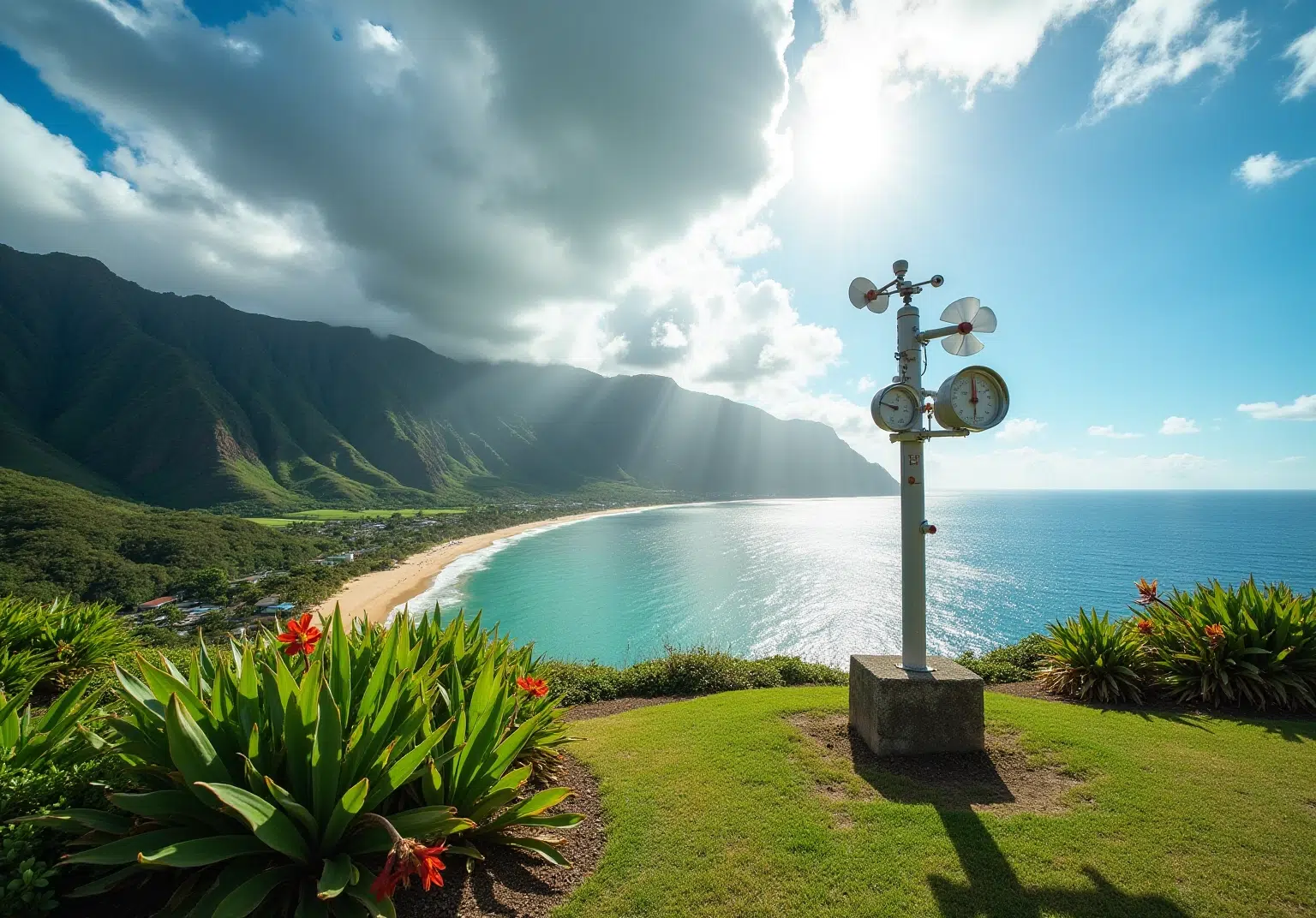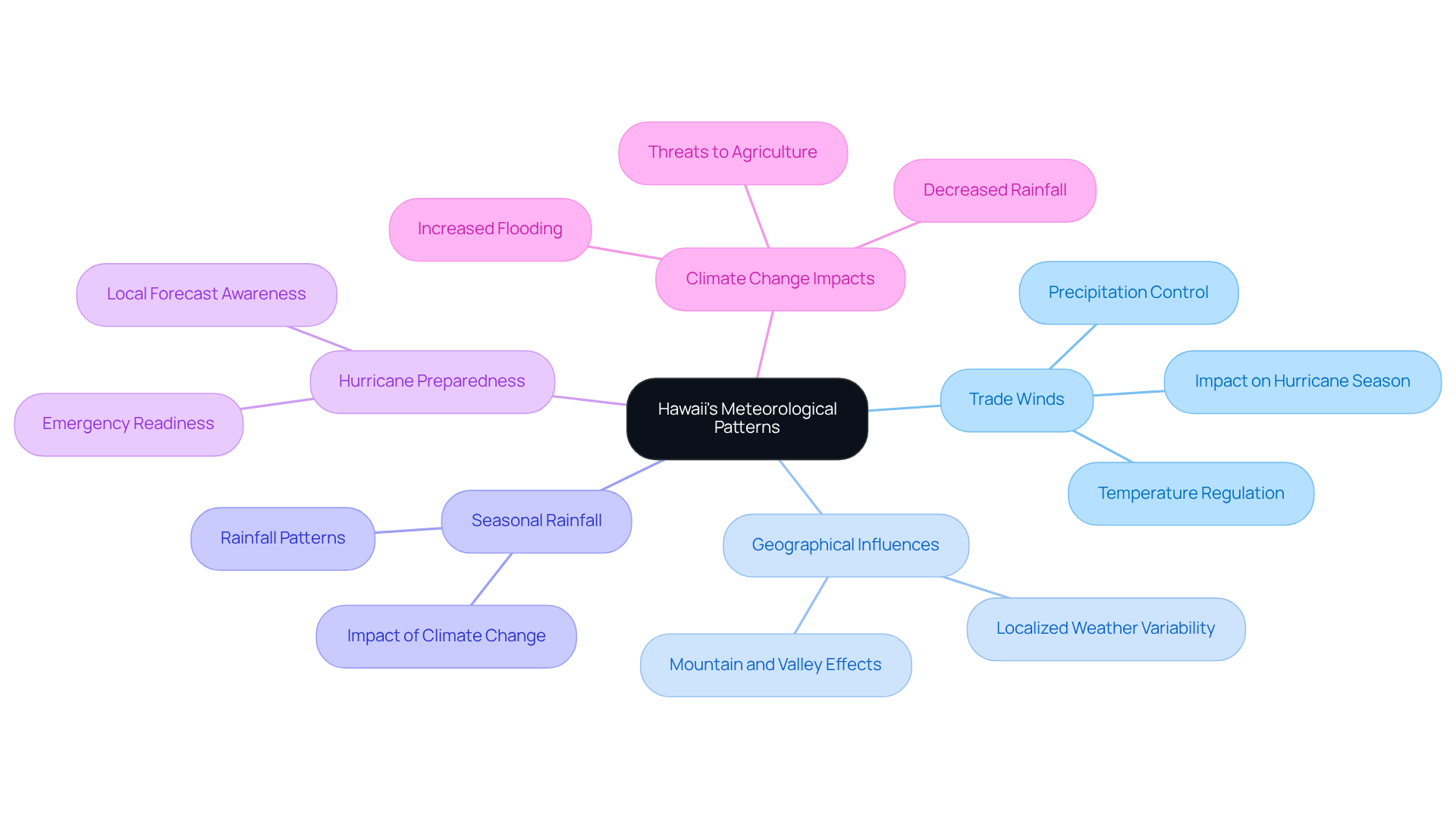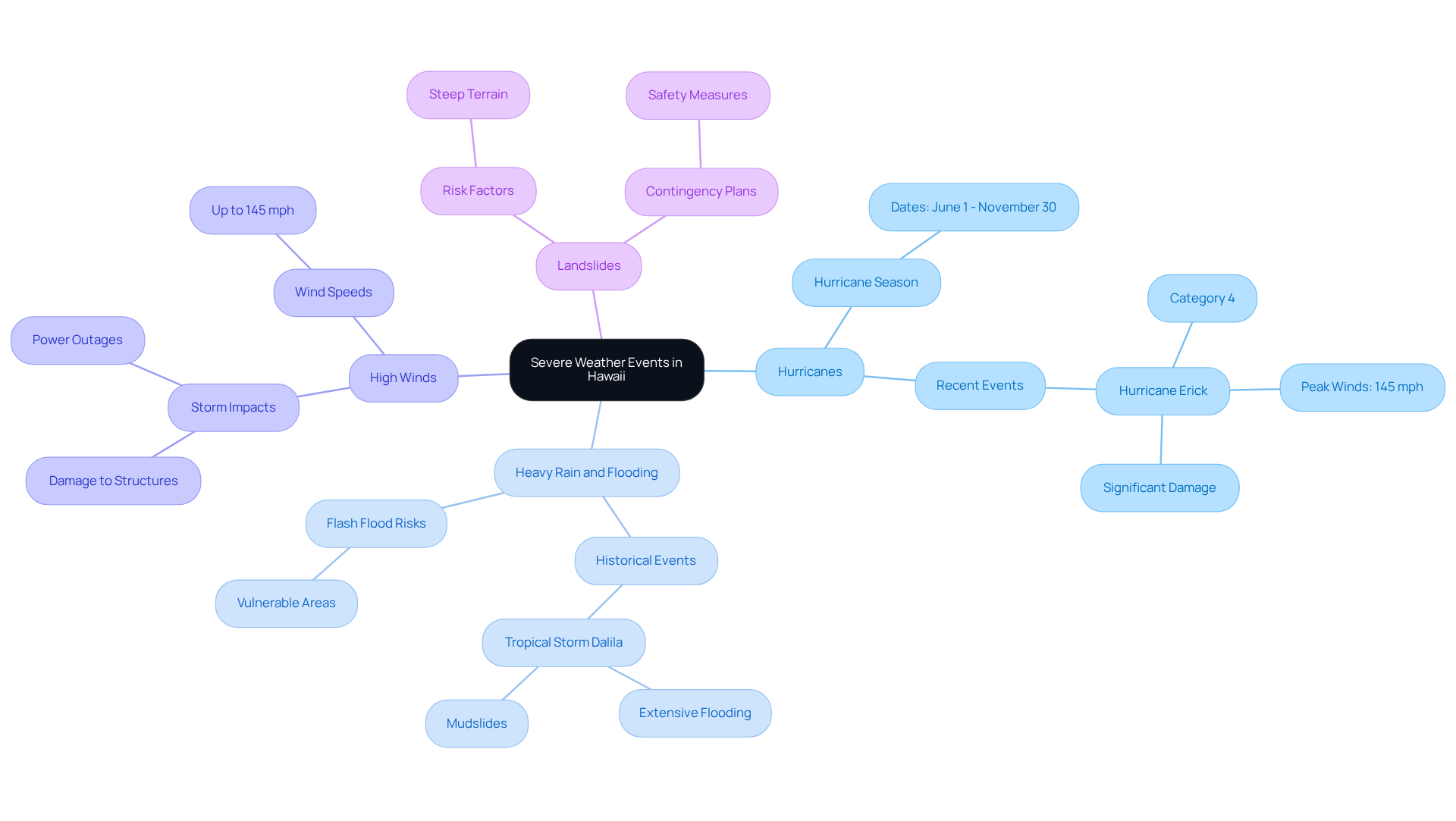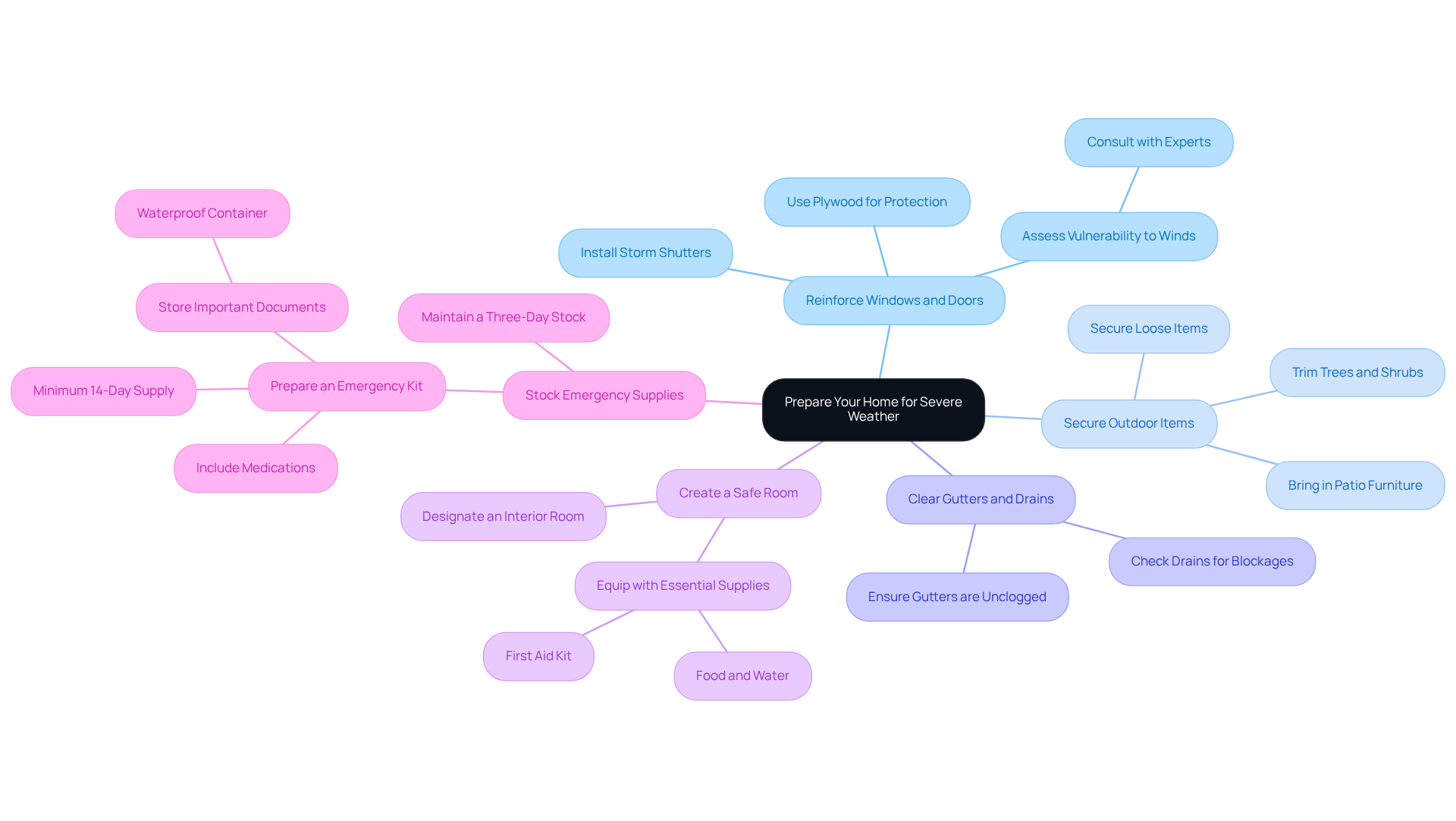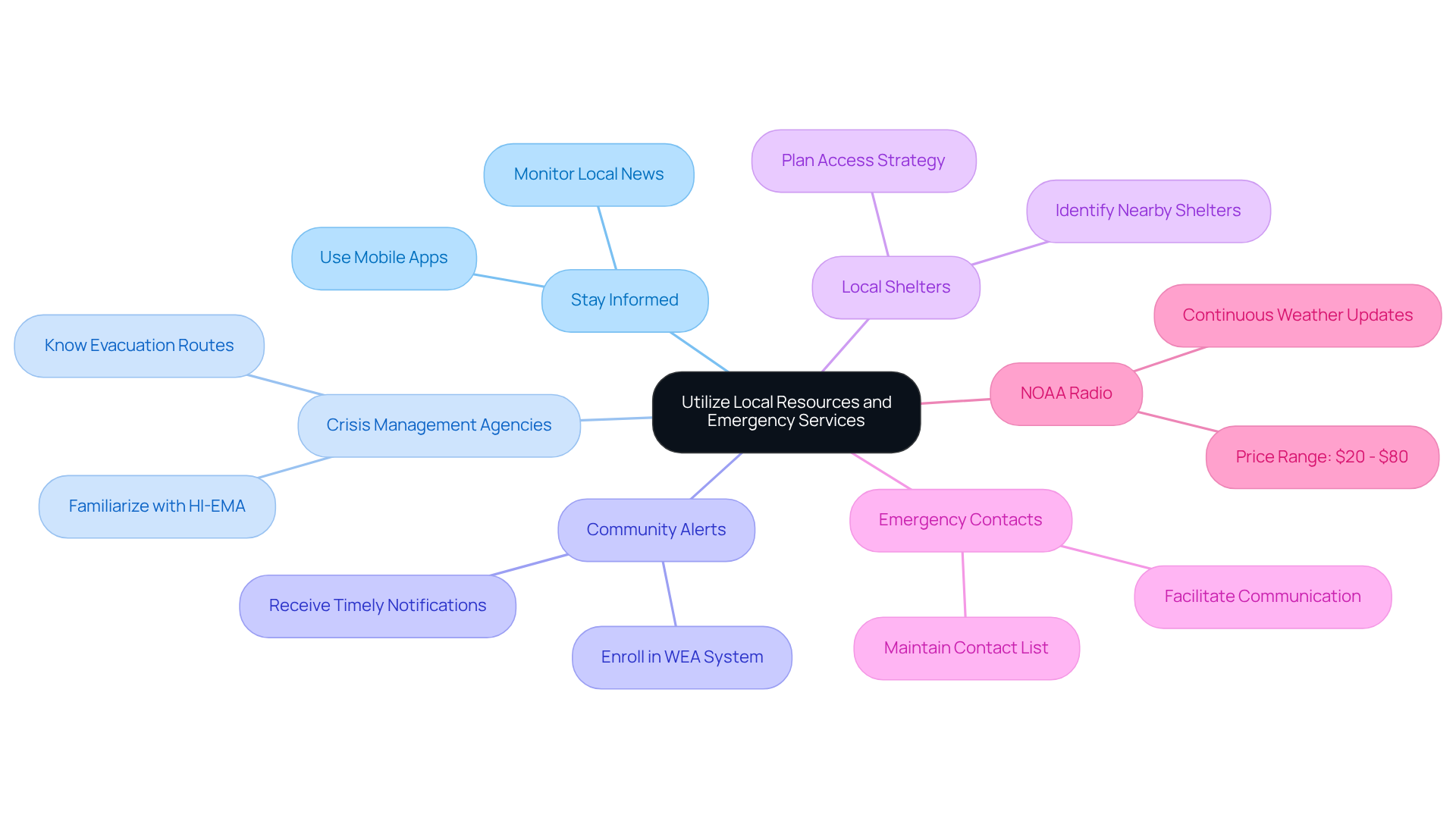Overview
This article addresses the essential safety tips for preparing for severe weather in Hawaii, recognizing the genuine concerns many may have about protecting themselves and their loved ones during events like hurricanes, heavy rainfall, and flooding. It emphasizes the importance of taking proactive measures to ensure safety, such as:
- Reinforcing windows
- Securing outdoor items
- Creating a safe room
- Utilizing local resources
These actions not only enhance individual safety but also contribute to community preparedness and resilience against the unique meteorological challenges faced in the region. Together, we can foster a safer environment for all.
Introduction
Hawaii’s breathtaking landscapes and tropical climate are often accompanied by unique and unpredictable weather patterns that can turn severe in an instant. As the hurricane season approaches, we understand that residents may feel anxious about the potential threats looming on the horizon, from heavy rains to destructive winds.
What strategies can individuals and families adopt to safeguard their homes and loved ones against these escalating risks? This article delves into essential safety tips and preparedness measures designed to empower Hawaii’s residents to navigate the challenges posed by nature.
Together, we can foster a resilient community, ensuring that everyone is equipped to face whatever comes our way.
Explore the Unique Meteorological Patterns of Hawaii
Hawaii’s tropical climate is profoundly influenced by trade winds and the islands’ varied elevations, resulting in a rich tapestry of atmospheric patterns. These include warm temperatures, high humidity, and seasonal rainfall, all of which play a crucial role in the region’s ecology and daily life. We understand that the impact of trade winds is especially important, as they assist in regulating temperatures and precipitation, but they can also lead to abrupt changes in conditions, particularly during hurricane season.
The islands’ distinct geography, marked by mountains and valleys, generates localized climatic phenomena that can differ significantly from one region to another. For instance, while one side of an island may experience heavy rainfall, the opposite side could be basking in sunshine. This variability highlights the significance for residents to remain aware of their specific region’s climate conditions.
As Hawaii approaches the hurricane season in 2025, understanding these meteorological patterns becomes even more critical. Observing local forecasts and understanding the implications of shifting atmospheric conditions can significantly improve readiness efforts for severe weather in Hawaii, ensuring that residents are prepared to react to extreme events such as hurricanes, heavy rains, and flash floods.
Moreover, recent statistics indicate that rainfall is expected to decrease by up to 30% in wet areas by the end of the century, which could exacerbate the challenges posed by climate change. It’s common to feel concerned about the rising occurrence of floods, demonstrated by the ‘rain bomb’ event on Kaua‘i in April 2018, when 50 inches of rain fell in merely 24 hours. This emphasizes the urgent need for residents to prepare for severe conditions. Additionally, the count of high tide flooding days in Honolulu has increased from 6 days annually to 11 days annually, further demonstrating the shifting climatic patterns in the region.
These changes not only threaten the safety of residents but also impact local agriculture and water resources. Together, we must recognize the importance of staying informed and proactive in our preparedness efforts, ensuring a supportive community in the face of these challenges.
Identify Common Severe Weather Events in Hawaii
Hawaii faces a variety of severe weather events, each posing unique challenges that can impact our lives deeply:
-
Hurricanes: The hurricane season, stretching from June 1 to November 30, brings the risk of tropical storms and hurricanes to our beautiful islands. Recently, Hurricane Erick intensified into a Category 4 storm, reaching peak winds of 145 mph and causing significant damage in affected areas. This serves as a stark reminder of the potential severity of severe weather in Hawaii and emphasizes the importance of being prepared.
-
Heavy Rain and Flooding: Intense rainfall can trigger flash floods, particularly in low-lying areas where families may feel vulnerable. Historical events have shown that heavy rains can lead to significant flooding, making it essential to be aware of flood zones and evacuation routes. For instance, Tropical Storm Dalila caused extensive flooding and mudslides in coastal regions of Hawaii, highlighting the need for readiness and community support in response to severe weather in Hawaii.
-
High Winds: Storms often bring strong winds that can damage structures and uproot trees, leading to power outages and hazardous conditions. This past hurricane season has seen winds reaching up to 145 mph, underscoring the need for robust infrastructure and emergency plans. We understand that severe weather in Hawaii can be alarming, but together we can prepare effectively for it.
-
Landslides: The steep terrain of Hawaii increases the risk of landslides during heavy rains, which can threaten homes and disrupt transportation. It’s crucial for residents to be informed about the areas most susceptible to landslides and to have contingency plans in place to ensure safety.
Comprehending these severe weather events in Hawaii is vital for creating effective safety plans and response strategies. As local emergency management officials emphasize, “During a Tropical Cyclone, being prepared is vital for you and your family. If it’s safe, staying at home is often the best choice.” Being prepared is essential, especially with forecasts suggesting one to four tropical cyclones this season. The designation of the state as a NWS StormReady area further emphasizes the significance of community preparedness for natural hazards. Together, we can navigate these challenges with confidence and care.
Prepare Your Home for Severe Weather: Essential Safety Measures
To prepare your home for severe weather, it’s essential to consider some safety measures that can provide peace of mind during challenging times:
- Reinforce Windows and Doors: Installing storm shutters or using plywood can protect your windows from flying debris, significantly reducing the risk of damage during hurricanes. It’s important to secure these vulnerable areas, as wind can easily compromise unprotected openings. James Barros from the Hawaii Emergency Management Agency emphasizes that assessing your house’s vulnerability to severe weather in Hawaii, especially winds, is a critical first step.
- Secure Outdoor Items: Bringing in or securing patio furniture, garden tools, and other loose items can prevent them from becoming projectiles in high winds. Trimming trees and shrubs is another simple yet effective step to prevent branches from causing damage during storms, safeguarding both your loved ones and property.
- Clear Gutters and Drains: Ensuring that gutters and drains are clear is vital to prevent flooding and water damage. Clogged gutters can lead to water pooling around your home, increasing the risk of structural damage.
- Create a Safe Room: Designating a room in your home as a safe space during severe weather—ideally, one that is interior and away from windows—can provide a comforting refuge. This room should be equipped with essential supplies to ensure the safety of your family during storms.
- Stock Emergency Supplies: Preparing an emergency kit with essentials like food, water, medications, flashlights, and a battery-operated radio is crucial. It’s advisable to have enough supplies for at least 14 days, as access to resources may be limited during and after a storm. Important items to include are a first aid kit, extra batteries, and copies of identification stored in a waterproof container. Local officials recommend maintaining at least a three-day stock of non-perishable food and water, highlighting the significance of being ready.
By implementing these proactive steps, you can greatly enhance your safety and resilience against severe weather in Hawaii, including the specific challenges presented by hurricanes in your area, such as storm surges and flooding. Together, we can ensure that you and your loved ones are well-prepared and protected.
Utilize Local Resources and Emergency Services During Severe Weather
During severe weather, it’s crucial for residents to effectively utilize local resources and emergency services to ensure safety and peace of mind:
- Stay Informed: We understand how unsettling severe weather can be. Regularly monitor local news and weather updates through radio, television, or mobile apps to receive real-time information about severe weather in Hawaii. Staying informed is your first line of defense.
- Crisis Management Agencies: Familiarize yourself with the Hawaii Crisis Management Agency (HI-EMA) and local response services. Knowing evacuation routes and available shelters can make all the difference. HI-EMA issues various notifications, including intense climate alerts and local crises, to keep you and your loved ones informed.
- Community Alerts: It’s common to feel anxious during emergencies. Enroll in community alert systems, such as the Wireless Emergency Alerts (WEA) system, to receive timely notifications about severe weather in Hawaii and urgent situations, ensuring you remain well-informed when it matters most.
- Local Shelters: Planning ahead can ease anxiety. Determine the locations of nearby urgent shelters beforehand, and establish a clear strategy for accessing these shelters swiftly if evacuation is required. Together, we can ensure you are prepared.
- Emergency Contacts: Maintain a readily accessible list of emergency contacts, including family members, neighbors, and local emergency services. This will facilitate communication during crises, providing a sense of security.
- NOAA Radio: Consider acquiring a NOAA Radio unit, which offers continuous updates on atmospheric conditions. These units typically range in price from $20 to $80 and are essential for staying informed during severe weather in Hawaii. Investing in one can provide peace of mind when the weather turns severe.
Conclusion
Understanding the unique weather patterns of Hawaii and the potential for severe weather events is vital for residents and visitors alike. We recognize that the tropical climate, influenced by trade winds and diverse elevations, can be a source of concern, making a proactive approach to preparedness essential. As the hurricane season approaches, it’s common to feel anxious about the risks associated with hurricanes, heavy rainfall, and high winds. Being aware of these risks is increasingly important for ensuring the safety of both individuals and communities.
Key insights from this article emphasize the importance of being informed about local weather phenomena. By preparing homes with essential safety measures and utilizing local resources during emergencies, we can work together to enhance resilience against severe weather. From reinforcing windows and securing outdoor items to maintaining emergency contact lists and staying updated through reliable channels, these steps can significantly bolster our collective safety. Moreover, understanding the role of community support and local emergency services is crucial in creating a safer environment for everyone.
Ultimately, the significance of preparation cannot be overstated. By taking the necessary precautions and staying informed, residents can foster a culture of safety and readiness in the face of Hawaii’s ever-changing climate. Embracing these proactive measures not only protects individuals and families but also strengthens the community as a whole. Together, we can ensure that everyone is better equipped to navigate the challenges posed by severe weather.


